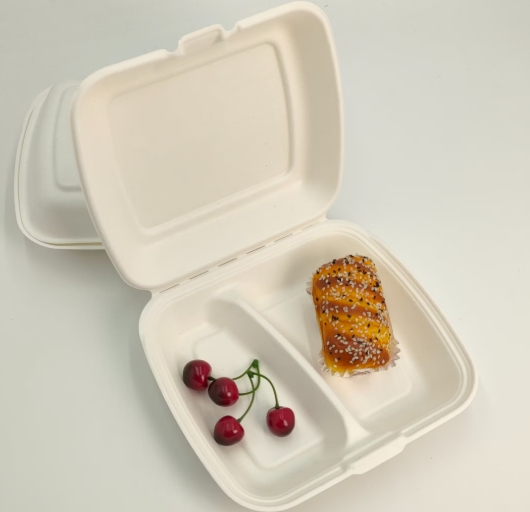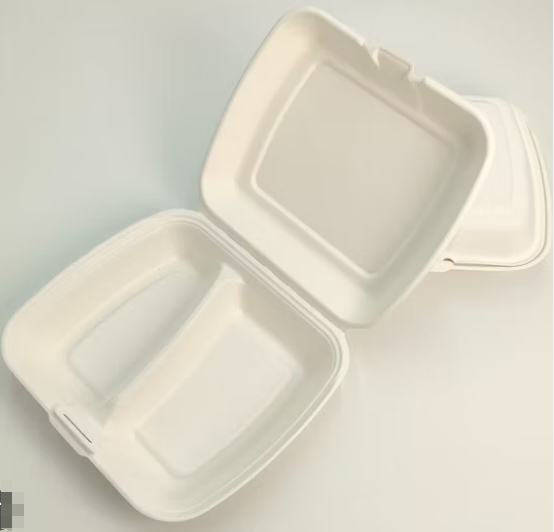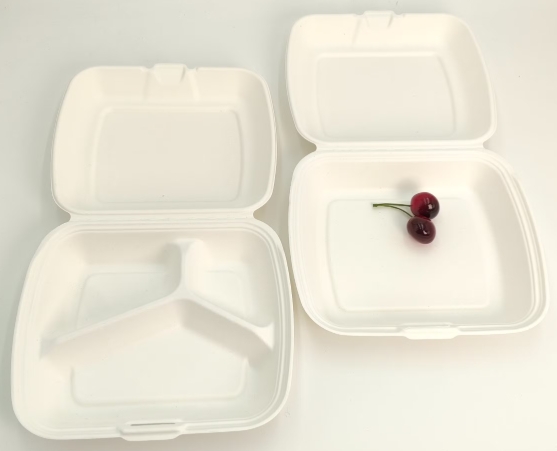
Content Menu
● Understanding the Key Players
>> What is a Sugarcane Pulp Clamshell Box?
>> What is a Bamboo Fiber Box?
● Origins and Material Sourcing
>> Sugarcane Pulp Sourcing
>> Bamboo Fiber Sourcing
● Manufacturing Processes
>> Sugarcane Pulp Box Production
>> Bamboo Fiber Box Production
● Environmental Impacts
>> Resource Renewability
>> Waste Management and Biodegradability
>> Energy and Emissions in Production
● Performance and Usability
>> Functional Strength
>> Heat and Moisture Resistance
>> Visual Appeal
>> Branding Flexibility
● Economic and Commercial Considerations
>> Pricing
>> Scalability
>> Suitability for Small Businesses
● Ethical and Social Impacts
>> Community Involvement
>> Land Use and Agriculture
● Trends in Sustainable Packaging
● The Verdict: Which Packaging Option Wins?
● Conclusion
● FAQ
>> 1. What are the main advantages of sugarcane pulp clamshell boxes?
>> 2. Are bamboo fiber boxes more durable than sugarcane pulp boxes?
>> 3. Can both packaging materials be composted at home?
>> 4. How should businesses decide which option to choose?
>> 5. Are there any challenges in switching from plastic to plant-based packaging?
Sustainable packaging has become a beacon for environmentally conscious businesses and consumers. As the tide turns against single-use plastics and non-renewable materials, alternative solutions like the sugarcane pulp clamshell box and the bamboo fiber box stand at the forefront. Both have been celebrated for their renewability and eco-friendly appeal, but which option truly leads in sustainability, performance, and usability? This article presents an in-depth exploration of these two packaging materials, analyzing their origins, manufacturing processes, environmental impact, functional benefits, and broader implications for businesses and consumers alike.

Understanding the Key Players
What is a Sugarcane Pulp Clamshell Box?
The sugarcane pulp clamshell box is made from bagasse, the fibrous residue left after extracting juice from sugarcane stalks. Instead of being discarded or burned, this byproduct is pulped, molded, and thermally pressed into durable containers. These boxes are often used in the food industry due to their heat resistance, strength, and smooth texture.
What is a Bamboo Fiber Box?
Bamboo fiber boxes are manufactured from cellulose derived from fast-growing bamboo plants. Through a process of harvesting, pulping, molding, and pressing, the bamboo is transformed into biodegradable containers that are both strong and naturally appealing. Bamboo packaging is gaining popularity among premium food service brands, as well as eco-conscious companies looking to stand out.
Origins and Material Sourcing
Sugarcane Pulp Sourcing
Sugarcane pulp is sourced from leftover bagasse, which is available in large quantities wherever sugarcane processing takes place. The advantage of using bagasse lies in its status as an agricultural waste product—no new farming is required specifically for packaging purposes. This closes the loop on waste and adds value to an already productive supply chain.
Bamboo Fiber Sourcing
Bamboo, one of the fastest-growing plants, is harvested from managed plantations. It grows rapidly without extensive chemical inputs and regenerates naturally after cutting. This sustainable growth cycle makes bamboo an appealing option for companies seeking low-impact packaging materials. However, careful land management is critical to avoid overharvesting or monoculture impacts.
Manufacturing Processes
Sugarcane Pulp Box Production
1. Collection – Bagasse is collected from sugar processing mills.
2. Pulping – The bagasse is cleaned and pulped into slurry form.
3. Molding – The slurry is molded into different packaging shapes.
4. Pressing and Drying – Molded items are hot-pressed and dried for strength.
5. Finishing – The finished boxes are trimmed, smoothed, and quality-checked.
Bamboo Fiber Box Production
1. Harvesting – Mature bamboo is cut and chopped into small pieces.
2. Fiber Extraction – Pulping processes remove fibers from the bamboo.
3. Molding – The bamboo pulp is shaped into containers.
4. Thermal Pressing – Boxes are pressed to set shape and structure.
5. Post-Processing – Final products are inspected and prepared for packaging.
Environmental Impacts
Resource Renewability
Sugarcane pulp's major environmental advantage is that it uses a byproduct that would otherwise be discarded. Bamboo, while renewable, is a more resource-specific crop, meaning it requires dedicated cultivation. Both materials are far more sustainable than petroleum-based plastics, but sugarcane has a slight advantage when it comes to land and water use efficiency since there is no need for separate farming.
Waste Management and Biodegradability
Sugarcane and bamboo packaging materials are both compostable and biodegradable. When processed without synthetic coatings or plastic linings, they can break down in home composting conditions. In municipal systems, the decomposition process is even faster. Their ability to return organic matter to the soil without toxic residues makes both materials favorites among eco-conscious consumers.
Energy and Emissions in Production
Sugarcane pulp production typically consumes moderate energy levels due to its reliance on residual materials. Bamboo fiber processing involves fiber separation which may be more energy intensive. However, the emissions impact of both is negligible compared to conventional plastic packaging, especially when renewable power is integrated into manufacturing.

Performance and Usability
Functional Strength
Sugarcane pulp boxes are oil and water resistant, suitable for hot and cold food items. Bamboo fiber boxes are slightly more resistant to tearing and better at retaining structure under pressure.
Heat and Moisture Resistance
Both packaging types perform well with hot foods and moist contents. Sugarcane pulp containers are often microwave safe, while bamboo fiber adds an elegant, premium feel to the food presentation without compromising thermal durability.
Visual Appeal
Sugarcane provides a slightly textured finish, giving it a raw, natural look. Bamboo fiber packaging tends to have a finer, smoother finish, making it more visually aligned with upscale branding needs.
Branding Flexibility
Both materials can be embossed or printed using vegetable or water-based inks. From logos to custom shape molds, sugarcane and bamboo both support strong branding opportunities.
Economic and Commercial Considerations
Pricing
Sugarcane pulp packaging generally has a cost advantage due to the surplus nature of its raw material. Bamboo packaging is often seen as a high-end alternative and therefore comes at a slightly higher cost. Over time, as bamboo production scales, this price gap is expected to narrow.
Scalability
Sugarcane packaging benefits from the widespread global sugar trade, meaning that sourcing bagasse is relatively easy in many regions. Bamboo requires more specialized cultivation and processing, which can present logistical challenges for widespread adoption.
Suitability for Small Businesses
Sugarcane boxes are usually more cost-effective and accessible, especially for small food vendors, cafes, and caterers. Bamboo is ideal for higher-end establishments focusing on brand aesthetics and environmentally elite clientele.
Ethical and Social Impacts
Community Involvement
By creating secondary markets for sugarcane farmers and bamboo growers, both materials offer rural economic opportunities. In particular, sugarcane packaging facilities help create employment in areas near sugar mills.
Land Use and Agriculture
Sugarcane packaging avoids crop replacement since it recycles existing outputs, whereas bamboo must be planted and harvested afresh. If cultivation is managed responsibly, bamboo can complement regional forestry programs. Nonetheless, balance is crucial to prevent deforestation or monoculture dependency.
Trends in Sustainable Packaging
- The rise in ban on single-use plastics has boosted demand for plant-based alternatives.
- Consumers increasingly favor products highlighting their use of renewable, compostable materials.
- Certifications and verifications further validate the eco-credibility of packaging suppliers.
Businesses looking to align with global environmental movements are increasingly opting for biodegradable materials, both for practical waste management and consumer appeal.
The Verdict: Which Packaging Option Wins?
The comparison between sugarcane pulp clamshell boxes and bamboo fiber boxes highlights that both are excellent eco-friendly alternatives. Here's a verdict breakdown by category:
- Sustainability: Sugarcane pulp wins by turning agricultural waste into valuable products.
- Durability and Premium Appeal: Bamboo fiber edges out slightly with its strength and finish.
- Cost and Accessibility: Sugarcane offers better affordability and broader availability.
- Compostability: Both score equally high for home and industrial composting.
The final choice depends on business goals. Companies focused on affordability, waste elimination, and practical usage may lean toward sugarcane pulp. Those targeting upscale markets or prioritizing aesthetics might prefer bamboo fiber.
Conclusion
Today's world demands packaging solutions that are both functional and environmentally responsible. Sugarcane pulp clamshell boxes and bamboo fiber boxes offer innovative responses to the plastic crisis. Each has unique strengths and applications, and selecting one over the other depends heavily on your brand's purpose, audience needs, and environmental values.
Embracing either option means contributing to a circular economy and reducing dependency on fossil fuels. In the end, it is not just about selecting a sustainable product, but about embracing a sustainable mindset—one packaging decision at a time.

FAQ
1. What are the main advantages of sugarcane pulp clamshell boxes?
Sugarcane pulp clamshell boxes are made from renewable and biodegradable agricultural waste, making them highly sustainable. They are strong, oil- and water-resistant, heat-safe, and affordable for most businesses.
2. Are bamboo fiber boxes more durable than sugarcane pulp boxes?
Bamboo fiber boxes are typically more durable because of the strength of bamboo fibers. They maintain their shape better under pressure and are ideal for heavy or moist food packaging.
3. Can both packaging materials be composted at home?
Yes. Both sugarcane and bamboo-based packaging products can be composted at home, provided they are free from plastic linings or synthetic coatings. Under proper composting conditions, they decompose into nutrient-rich soil.
4. How should businesses decide which option to choose?
Businesses should consider local availability, costs, functional needs, and brand image. Packaging decisions are best made after assessing the entire product lifecycle and disposal options available in the business's region.
5. Are there any challenges in switching from plastic to plant-based packaging?
Yes, challenges include cost adjustment, supply chain adaptation, and educating staff and customers on proper disposal. However, long-term benefits like reduced carbon footprint and brand value improvement make the switch worthwhile.

















